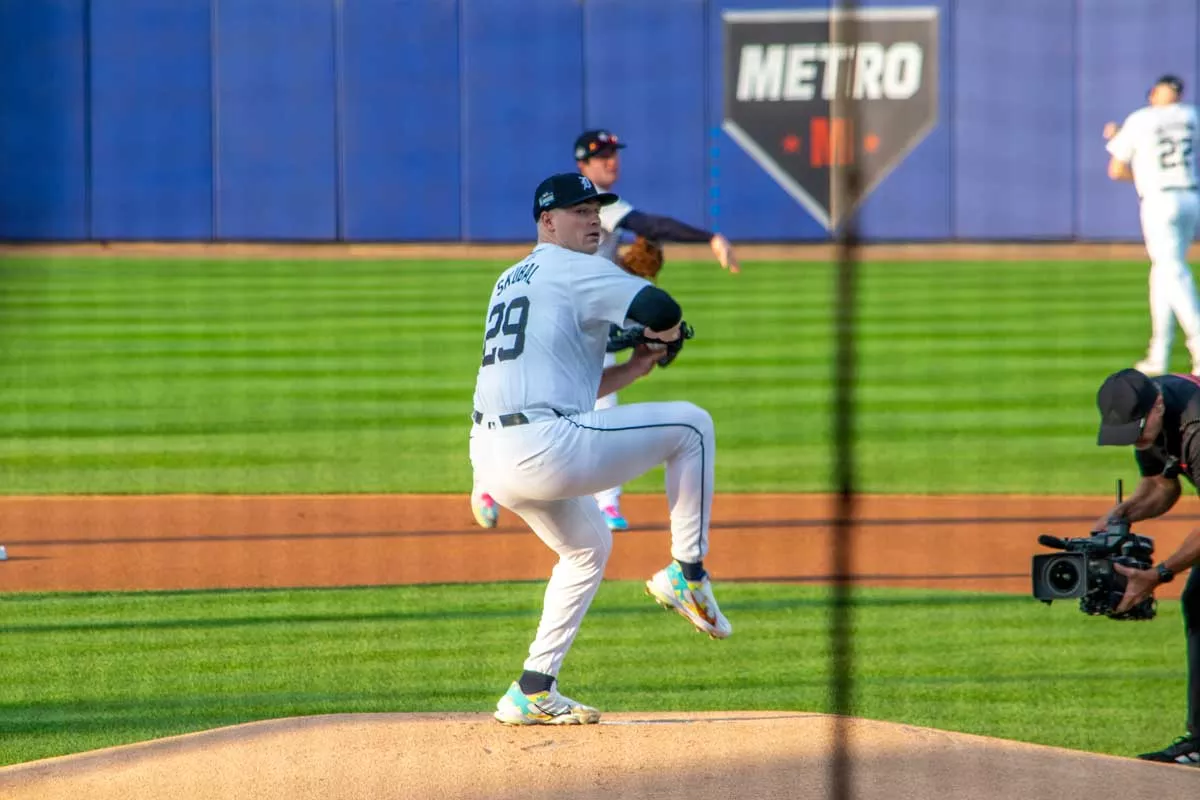Last year, no one from the Detroit Tigers organization ever seemed particularly surprised by the team’s remarkable — and improbable — late-season winning streak that led to their first MLB playoff appearance since 2014.
For those of you who need a recap: On August 10, 2024, the Tigers were eight games under .500 (55-63), their season seemingly drawing to another unremarkable finish. The team had even sold off starting pitcher Jack Flaherty, catcher Carson Kelly, and left-handed reliever Andrew Chafin at the MLB trading deadline.
Most observers assumed the Tigers were done competing for the year and would resume their organizational rebuilding process.
But after August 10, when Fangraphs gave the Tigers a 0.2% chance of making the postseason, they proceeded to go 31-13 (a .705 winning percentage) and clinch a wild card spot in the American League playoffs.
The @Tigers had a 0.2% chance of making the #postseason on August 11th, according to @fangraphs.
— MLB (@MLB) October 2, 2024
They just SWEPT their AL #WildCard Series matchup! pic.twitter.com/BQN4tRCQns
In addition to that remarkable winning streak, they also needed the simultaneous late-season collapse of division rival Minnesota. Sure enough, the Twins wilted down the stretch and finished the season 17-29.
Without that unlikely scenario, the Tigers wouldn’t have made the playoffs.
In the midst of this improbable, almost magical run of success, Tigers manager A.J. Hinch did a masterful job of utilizing his young, hard-throwing pitching staff.
Managing the unpredictability of their so-called “pitching chaos,” Hinch and his staff mapped out a highly adaptive and constantly shifting plan based on each of his pitchers’ abilities and how they could best be used in daily matchups against opposing lineups.
A plan called chaos
For the Tigers to successfully execute the plan, each pitcher had to be willing to adapt to a constantly shifting set of variables and fully embrace the advance preparation offered by their coaches and analytics staff, looking beyond preconceived pitching roles (and even leaving a little of their egos behind in the process).
Seemingly, the entire pitching staff bought into this unconventional plan.
“Not knowing when [you’re] going to get called, it is chaos at times,” Tigers pitcher Beau Brieske told MLB.com. “So you try to just be ready. The thing that I always tell myself is, ‘You’ve got to trust that if your name’s getting called, there’s a reason for it and you're the guy for the situation. You've got to go out there, do your job and that’s it. You don’t try to make it more than what it is, and you just trust that the next guy’s going to pick you up and there’s a plan.’ It’s not just randomness.”
The Tigers’ success during one and half months of playing very good baseball exceeded their play over the season’s long seven months and had a dramatic effect on the perception of a franchise’s success.
If the Tigers hadn’t made their presence felt in the playoffs last year, fans likely still would’ve had an increased level of excitement entering this season. But instead, the Tigers’ surprising postseason success has only further heightened the expectations of an otherwise recently dormant baseball fan base.
Any 2025 season preview has to consider that Tigers fans are primed to watch a successful and competitive team, regardless of just how rare the circumstances were that conspired to make them a playoff team in 2024.
“Baseball is the most perfect of games, solid, true, pure and precious as diamonds,” W.P. Kinsella wrote in Shoeless Joe. “If only life were so simple. Within the baselines anything can happen. Tides can reverse; oceans can open. That’s why they say, ‘The game is never over until the last man is out.’ Colors can change, lives can alter, anything is possible in this gentle, flawless, loving game.”
As Kinsella suggests, many baseball fans are willing to suspend their disbelief for their favorite team. The surprising end to the Tigers’ 2024 season only further supports fans suspending their disbelief in the hopes of an even better outcome in 2025.
With the home opener finally upon us, most Tigers fans are expecting a very successful and highly competitive 2025 campaign. And they have a number of good reasons to expect more this year, most notably all 13 members of Detroit’s top-tier pitching staff.
Many fans are also expecting to see improvement from young core players like outfielders Riley Greene and Kerry Carpenter, center fielder Parker Meadows (currently recovering from a shoulder injury), catcher Dillon Dingler, and newly minted first baseman Colt Keith.
Plus they’ve added a talented veteran in second baseman Gleyber Torres (who’s performed well at Comerica Park) on a contract that will yield big rewards for him next season, contingent upon a successful 2025.
Torres should be highly motivated.
The Tigers do still carry the burden of shortstop Javier Baez and former first baseman and once highly touted draft prospect Spencer Torkelson.
Both players have a tenuous hold on their roster spots, with increasingly diminished expectations. So how will the Tigers integrate them into the mix this season without costing the team?

Anything can happen
Can a variation of “pitching chaos” yield productive performances from each of them?
Remember: Within the baselines, anything can happen. And from August 10 onward last season, the Tigers proved just that. But can fans still believe “anything is possible” in a media environment of 24-hour sports coverage and the daily, grinding skepticism of sports talk show hosts?
Are they inured from allowing themselves to hope for even more in a media environment where every last play is analyzed and scrutinized? In a longtime baseball stronghold like Detroit, I believe that without a doubt that they can. Fans want to believe that the Tigers are making considerable progress.
But what do baseball experts think? Are they just as bullish as fans? Does the Tigers’ end-of-season success last year change expectations?
Fangraphs is a popular website that features the statistical history of every Major League Baseball player, as well as both shared baseball industry-wide and proprietary analytical tools that are useful for both those inside and outside of the baseball industry.
Their “depth charts” feature is where you can find their playoff odds for each team and the projected standings for the upcoming season.
“The Depth Charts are pretty simple in theory,” writes Fangraphs’ Neil Weinberg. “They blend together two of the leading projection systems (Steamer and ZiPS) and then scale those projections to our expectations about playing time. … You can think of the Depth Charts as the baseline projections for the entire site, as they are the input for the projected standings, playoff odds, and game odds.”
Fangraphs’ depth charts are useful for a couple of reasons, Weinberg adds. “First, they blend two projection systems together without you having to do any of the work, and that’s helpful because aggregate projections are better than any one system.”
These proprietary projection systems also measure a team’s playoff odds based on their players’ performances as the season goes on.
Playoff odds are affected by players who either play above or below their expectations (which directly impacts changes in their playing time), as well as accounting for each injury as they occur.
Every season, injuries limit players from producing their originally expected performance and generally directly impacts the success of a team.
The 2025 Tigers are already facing injuries to starting pitcher Alex Cobb and outfielders Matt Vierling, Wenceel Perez, and Parker Meadows. A particularly prolonged injury (especially in the case of Meadows) would directly impact their expected playoff odds.
Fangraphs currently predicts the Tigers will go 82-80, one game behind the Minnesota Twins and just a game ahead of the Kansas City Royals.
Their initial expectation is basically for the AL Central to be a hotly contested race, with an exciting photo finish of teams who all appear remarkably well-matched as competitors.
That doesn’t seem far from what any of us can rightfully expect, given how competitive the division was in 2024.
Fangraphs’ Jay Jaffe indicates that their projections model doesn’t apply more weight to the Tigers’ last 44 games of 2024 except to the extent that the players’ stats likely improved over that span. Those projections are based on full-season numbers.
“Obviously the late-season run raised expectations for the fan base,” Jaffe says. “But the Tigers may not have been aggressive enough in terms of shoring up the roster for a similar run — but they did seem to get good bargains in re-signing (Jack) Flaherty and adding (Gleyber) Torres.”
The Tigers clearly have some weak spots or at least some uncertainty, Jaffe says. “(Spencer) Torkelson hasn’t panned out, the infielders on the left side (shortstop Trey Sweeney and recently demoted third baseman Jace Jung) don’t have very strong projections, and right field looked particularly weak even with (a healthy Matt) Vierling.
Analytics are the most dispassionate and least intangible method of gauging expectations. They’re useful but they’re even better for measuring actual in-game performance.
There are also components of the game that analytics can’t really account for. There are no discrete measures for momentum or a vibe that surrounds the performance of a team.
That’s why we asked longtime Motor City Metrics and the Detroit Tigers Minor League Report podcasters Rogelio Castillo and Chris Brown for their thoughts about this season and increased fan expectations.
The view from the cheap seats
Each long-running podcast closely follows the Tigers and their entire organization while maintaining the balance of objective analysis and understanding subjectively how fans and experts are feeling about organizational decisions and team performance.
For so many of us as baseball fans, a team is much more than a set of data points. We see progress based on more than just quantitative measures. There are qualitative differences that Brown and Castillo have monitored closely along the way while the team has developed the top farm system in all of Major League Baseball (according to MLB Pipeline).
We asked Brown and Castillo if fans should have higher expectations after the team’s spectacular 44-game performance to end the regular season last year. Each of their responses were unique, but they also echoed similar thoughts.
“Proceed with caution,” Castillo says. “The young core (of the team) is improving. Riley Greene and Colt Keith continue to develop, and they were key parts of that strong finish. If they take another step forward, the offense could see real gains.”
“I think baseball fans should almost always be cautiously optimistic heading into the season because you just never know what might happen,” says Brown. “Last year is one great example of why, and I’d argue 2006 was probably one of the 10 greatest seasons in franchise history, partially because no one saw it coming.”
Brown and Castillo agreed that the Tigers’ strong pitching staff, led by Cy Young Award winner Tarik Skubal, would help the team remain very competitive.
Inevitably, the Tigers will have to decide whether to deal Skubal for prospects if the team falls short of its postseason goals.
tweet this
“Pitching will keep them in games,” Castillo says. “Tarik Skubal looked like a legitimate ace down the stretch, Reese Olson showed promise, and Casey Mize is back in the mix. The Tigers have enough pitching depth to be competitive most nights.”
“Getting Jack Flaherty back was a coup,” Brown adds, “even if he doesn’t quite match what he did in 2024. Reese Olson and Casey Mize have looked stellar this spring, and (rookie pitcher) Jackson Jobe has some of the best pure stuff in baseball, even if he hasn’t quite harnessed it yet. This is the best, deepest Tigers rotation in at least a decade.”
Not surprisingly, they also had similar concerns for the 2025 season.
“Outfield depth is a concern,” Castillo says. “Beyond Double-A (Erie), the Tigers don’t have much reliable outfield depth. If (Riley) Greene and Parker (Meadows) aren’t healthy, it puts the team in a bind for a reliable source of offense.”
Unfortunately, the Tigers also have the recent injuries of outfielders Matt Vierling and Wenceel Perez to consider.
Brown agrees that the injuries to Meadows and Vierling are a big concern, and adds that the vague nature of their recovery timelines doesn’t inspire much confidence.
“By wRC+ (an analytical measure of player performance) they were two of Detroit’s four best offensive players last year. And Parker Meadows sure seemed to be in the middle of a lot of huge plays down the stretch. Adding Gleyber Torres should help, but the longer Meadows and Vierling remain sidelined, the less optimistic I am about the Tigers’ chances.”
Island of Misfit Toys
To address those concerns, the team just added journeyman outfielder Manny Margot, who should provide a veteran counterbalance to the team’s vulnerability against left-handed pitching.
If there’s one criticism to be levied, it’s that the Tigers weren’t fully successful in their attempts to upgrade positions of organizational need in an admittedly weak free-agent class.
Their well-documented pursuit of former Astros (and now Red Sox) third baseman Alex Bregman proved fruitless, leaving them hoping for considerable improvement by their default in-house option, young Jace Jung.
But Jung has been sent down to Triple A Toledo, and the Tigers’ infield is starting to look like the Island of Misfit Toys.
“Unfortunately, I worry that bad defense and poor offense might undo the whole thing,” Brown says. “The probable Opening Day roster has a very underwhelming, slapdash feel to it. Multiple players are being asked to try new defensive positions, and the Tigers are likely to trot out at least five below-average (or worse) defenders in Los Angeles.”
Castillo suggests that we can still trust the process, noting that Tigers President of Baseball Operations Scott Harris has made some smart, if not flashy, moves. “The team is adding depth without overcommitting to long-term contracts that could eventually backfire.”
As a fan, it’s fair to wonder if hubris played any part in how the Tigers approached the offseason. Just like the buy-in needed by the pitchers to support “pitching chaos,” players throughout the organization are now being asked (after an incredible end-of-season inducement of making the playoffs) to trust the efficacy of the organization’s decision-making.
The elephant on the field
And then there’s the massive elephant on the field: the Tigers’ Cy Young Award winning pitcher, Tarik Skubal.
From our view here in the cheap seats, initial discussions about a contract extension for Skubal went nowhere. Now with two years remaining on his contract, the clock is ticking. But the Tigers have to balance winning now without entirely compromising the future of the franchise.
Adding Bregman would’ve solidified the team’s commitment to winning within the short window remaining in Skubal’s contract. Inevitably, the Tigers will have to decide whether to deal Skubal for prospects if the team falls short of its postseason goals.
The team can now be confident in its own resilience and trust its on-field leadership, headed by manager A.J. Hinch.
So what should we expect from the Tigers this year?
“Expectations should be higher than last year, but cautiously so,” Castillo says. “The Tigers aren’t a lock for the playoffs, but a .500 or better season is a realistic goal. Still, the margin for error is still thin.”
“I would tell fans to go ahead and be optimistic, because that’s more fun,” Brown adds. “But also expect a roughly .500 record.”
For my part, I have the same measured expectations for the team — but I also can’t forget what it felt like just a few months ago after Andy Ibanez’s game-winning double off of Astros closer Josh Hader and Kerry Carpenter’s breathtaking home run off of Guardians closer Emmanuel Clase in the ALDS (a series that the Tigers still lost).
“You win a few, you lose a few,” said Satchel Paige. “Some get rained out, but you got to dress for all of them.”
Ultimately, the Tigers have proved that you can’t count this team out. They’re a resilient bunch, and they’ve got the right combination of quality leadership and talented players who believe enough in this organization — and in themselves — to remain bullish on their future after last year’s surprising playoff run.
I’m cautiously optimistic about the Tigers this season — without being unreasonable about their circumstances. But I won’t be surprised if the team struggles at times. I also know that you can’t rule ’em out until they’ve fully run out of chances.
If anything, their spectacular 44-game run only reinforces just how special it was last year. Expecting that again is a lot to ask for. But we do know that this organization can’t easily be counted out.
And what more can we ask for?




